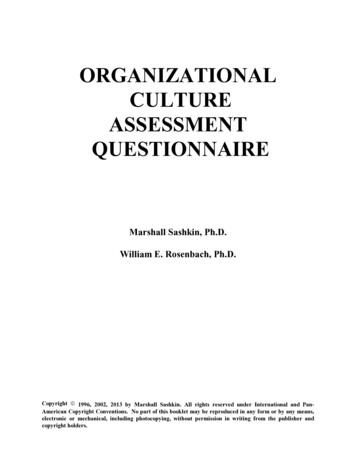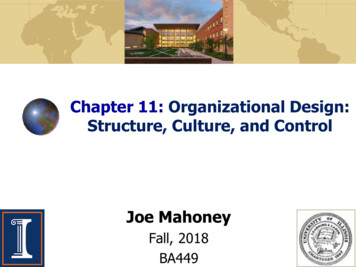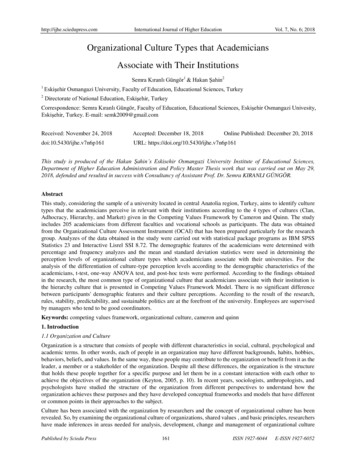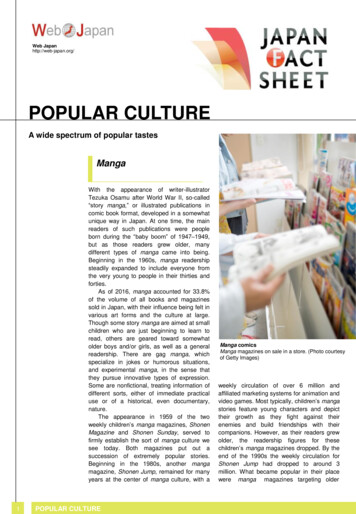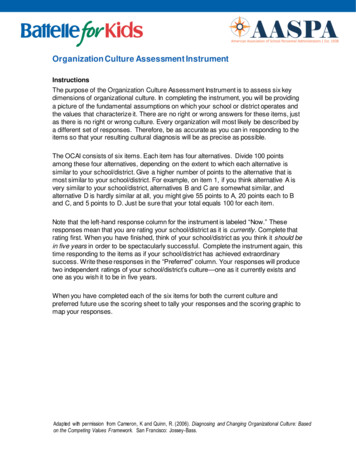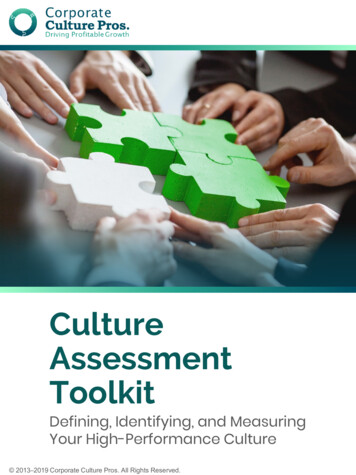
Transcription
CultureAssessmentToolkitDefining, Identifying, and MeasuringYour High-Performance CultureCorporateCulturePros.com – 303-898-3920 2013 2019 Corporate Culture Pros. All Rights Reserved. 2013 2019 Corporate Culture Pros. All Rights Reserved.
Copyright and AuthorizedLicense Use of CultureAssessment Toolkit ContentsCopyright 2013-2019 by Corporate Culture Pros. All rights reserved.This Toolkit or any portion thereof may not bereproduced or used in any manner whatsoeverwithout the express written permission of thepublisher. There are two exceptions: Internal training within the buyer’s companyfor up to 10 people; Use of brief quotations in a blog or book review.Produced in the United States of AmericaFirst Edition, 2013Published by:Corporate Culture Pros4 Pinyon Pine LaneLittleton, CO ros.com – 303-898-3920 2013 2019 Corporate Culture Pros. All Rights Reserved.
Getting StartedCulture Assessment ToolkitMeet Corporate Culture ProsWelcome! We are Corporate Culture Pros: A boutique consulting firmpassionate about creating workplaces that grow people,customers, and profit.Whether you are dealing with a merger/acquisition, digitaltransformation, or a turnaround you will find proven tricksand tools here. For over 20 years, we’ve dedicated ourcareers to training leaders and organizations how to leadcultural change to impact positive business performance.In the Digital Revolution, every single aspect of work – who,what, when, where, how – is transforming. Culture buildingignites widespread passion, leadership, and competitiveadvantage – ensuring YOUR organization evolves andadapts – versus facing extinction.This Assessment Toolkit will help you assess, diagnose, andpinpoint the habits you need to strengthen teamwork,collaboration, and the capacity for ongoing change.Visit us as CorporateCulturePros.com for more tips andtools on building cultures that can navigate the modernorganization.Lisa JacksonCEO / Co-FounderGerry SchmidtCo-Founder andPrincipalCorporateCulturePros.com – 303-898-3920 2013 2019CorporateCorporateCulture Pros.All RightsReserved. 2013-2019CulturePros. AllRights Reserved3
Getting StartedCulture Assessment ToolkitCulture DefinedHow people work together, that either helps or hindersyour ability to adapt, compete, win.Culture is Culture is notThe “glue” that fosterssuccessful implementationof a winning strategy. Behaviors that unify leaders,managers, technology andfront line service providers –and break silos. Clear definition of success:Financially and otherwise.The decision process anorganize uses to balancecompeting goals: Long andshort-term thinking, internalv. external stakeholders,change v. stability, people v.performance, innovation v.cost-cutting.Day-to-day methods forcreating transparencyacross the business:Prioritization, meetings,communication, attractingand retaining the right talent. Values and Beliefs. TheseCAN be important anchorsfor culture, but are oftenundefined or too fuzzy andintangible for people toknow what they mean.Posters, coffee mugs,t-shirts, games, food andbeer taps. These aresymbols of the culture, butmean little without the realwork of building connection.A fixed way of doing thingsregardless of style, taste,and circumstances. Culturein today’s global enterprisesneed common decisionprocesses while allowing forlocal spirit, style and pride.The executive’s view of whatthey think “culture” is. Mostoften, senior leaders havethe least accurate view ofthe culture.Bottom line:Are people in your company enabledto do their best work?CorporateCulturePros.com – 303-898-3920 2013 2019 Corporate Culture Pros. All Rights Reserved.4
Getting StartedCulture Assessment ToolkitCulture Building Benefits This Toolkit provides tips, tools and instructionsfor achieving 3 main outcomes in a team ororganization:Remove culturebarriers tobusiness growthand profitRetain greatpeople byenabling themto do theirbest workDevelop leaderswho can adaptto constantchangeCorporateCulturePros.com – 303-898-3920 2013 2019 Corporate Culture Pros. All Rights Reserved.5
Getting StartedCulture Assessment ToolkitWhy Culture?Business Case for Culture BuildingResults to ExpectCorporateCulturePros.com – 303-898-3920 2013 2019 Corporate Culture Pros. All Rights Reserved.6
Getting StartedCulture Assessment ToolkitNo More Steady State;Adapting is Essential to Innovation.As the world has flattened and becomemore transparent, there are newcompetitive forces requiring a greater rateof adaptation. Worker and customerexpectations are colliding with the ability ofan organization in any industry to meetcomplex demands and constant change.The “spaces between change” are shorterand smaller: There is no more steady state.Running a profitable business is harder.Annual changes in the Fortune 500 list – andprofitability - demonstrate how quickly youcan become extinct if you don’t adapt.In attempts to stay competitive, changeprograms and processes (cultural andother) have mushroomed in popularity. Doyou know the collective success rate of allefforts to lead change in business today?Multiple studies document the alarmingfailure rate (and billions of dollars wasted)on change/ improvement programs that fallshort. (next page.)To succeed in such a challengingera of change, leaders need an ongoingprocess for breaking down barriersinternally, engaging more people inexecuting strategy, and fostering highperforming teamwork. This ongoing methodis about building new habits of work – theenduring purpose of Culture Building.Today’s leaders mustchange how theylead in this era. Theymust focus on: Inspiring people Generating passionfor work Removingbureaucracy,randomprioritization, andarbitrary decisionmaking thatplagues so manyorganizations.The goal of Culture Buildingis to foster ongoing clarityand alignment, that createscompetitive advantage thatis difficult to copy.Being adaptable is acapability, not an event.Being adaptable is theseedbed for innovation.CorporateCulturePros.com – 303-898-3920 2013 2019 Corporate Culture Pros. All Rights Reserved.7
Getting StartedCulture Assessment ToolkitThe Failure Rate of ChangeCulture eatsstrategy forlunch Dick Clark, CEO, Merck“75% of change efforts end in failure”Mourier, Conquering Organizational Change, 2001“58% of change initiatives failed to reach their goals”McKinsey Survey, LaClair, J.A and R.P. Rao, 2002“63% of TQ or change initiatives in the high techindustry failed to achieve anticipated improvements”Schaffer R.H. and Thompson, H.A (1992) Successful change managementbegins with results, Harvard Business Review, January-February, 80-9 80“90% of TQM projects miss their target”Crosby, P. (1989) Quality is free. New York, McGraw Hill“Business Process Reengineering fails 50-70%”Steward, T.A. (1993) Reengineering: the Hot New Managing Tool,Fortune, 128, 4 pp 32-37CorporateCulturePros.com – 303-898-3920 2013 2019 Corporate Culture Pros. All Rights Reserved.8
Getting StartedCulture Assessment ToolkitWhy Change Really Fails . . .and The Magic WandYou probably know the standardreasons change fails:Leaders lack sustained commitment.(lack of sponsorship)Organizations get distracted.(flavor of the month, corporate ADHD)Change resistance.(low employee engagement)The Goldilocks Problem:Most successful change initiatives arebuilt in an environment that is “justright” for that environment. Then, theyare exported with the promise “This willwork for you too.” But when imported,they are Too Hot. or Too Cold – NeverJust Right. Why? Every group or systemhas unique mindsets, capabilities,challenges, and behaviors that ARECOMPLETELY UNIQUE. Any true capacityto adapt to change must be grownwithin, not imported from outside.The Fingerprints Rule is how youget it right: If you want people toown the work, you must create aprocess that allows them to DOthe work. This is especially truewith younger generations. Whenpeople know what’s importantand believe in your leadership,they can fix almost any problemin the business. The FingerprintsRule is like having all the superpowers and magic wands in thekingdom sitting in front of you why go to the mall to buy it?Your people KNOW how to helpyou compete better and build agreat workplace. You just haveto ask them.Culture Building meansactivating The FingerprintsRule: “What will help peoplewant this change?”CorporateCulturePros.com – 303-898-3920 2013 2019 Corporate Culture Pros. All Rights Reserved.9
Getting StartedCulture Assessment ToolkitContinuedThe Power ofFingerprints in ActionA consulting colleaguebrings small, crossfunctional groups ofpharmaceutical sales repstogether with a toughchallenge: Boost sales (inflat growth cycle) by 10%.How are you using theFingerprints Rule inyour organization?The Task: Give usimplementable solutionswithin defined andreasonable costboundaries. Workingagreement: Managers areexcluded from the meetingto ensure the most candiddiscussions.Nearly every time, thegroup’s plans produce amajor breakthrough inresults. Why? The keys tothe kingdom are in the righthands. Follow theFingerprints Rule bytapping the wisdom of thepeople closest to yourcustomers.CorporateCulturePros.com – 303-898-3920 2013 2019 Corporate Culture Pros. All Rights Reserved.10
Getting StartedCulture Assessment ToolkitResults You Should ExpectCulture Building must be grounded in a clear purpose. There are threeoutcomes our clients seek when committing to culture building:1. Remove Culture Barriers toBusiness PerformanceThe link between culture and businessperformance is proven. In every industryare companies who excel at innovationand exceeding customer expectations.Southwest Air. Amazon. Starbucks. Youdon’t have to be an iconic example toleverage corporate culture into betterfinancial performance. You just have toknow how to do it. This Toolkit providesthe map and the steps.2. Retain Great People, EnablingThem to Do Their Best WorkTop talent want to be challenged, notfrustrated by bureaucracy. If you want tokeep great people, you have to rethinkhierarchically driven, rule-based systemsand foster electric, energized, creativeteamwork. That’s when magic happens.What is it worth to you, to have 100 orseveral thousand people in yourorganization say “I LOVE working here” or“This is the best place I’ve ever worked!”This is what the Culture Builder Toolkit canhelp you do.Culture building createsgreat leaders ANDcompetitive advantage.3. Help Leaders Adapt toConstant ChangeEvery organization is facing more andfaster change. The marketplace is morecompetitive than ever, based ontechnology, the internet, andglobalization. Culture building canimprove any effort to successfully drivecontinuous change.CorporateCulturePros.com – 303-898-3920 2013 2019 Corporate Culture Pros. All Rights Reserved.11
Getting StartedCulture Assessment ToolkitWhen Should A Culture Change?Let’s begin with our two cents onwhen a culture should – and shouldnot - change. Transformationalchange is what all companies arefacing to attract and retain talent ina virtual world.When the business reality changes– especially big changes likemergers, turnaround, a new leadertakes the helm - an organization’spast strategy, structure, and culturedo not align to the New Reality. Thiscreates Tension. (see next 4 slides).The business may begin to slip in itsability to perform, allow people to dotheir best work. Change effortsoverwhelm people, making it harderto adapt.When an organization is pursuing anew strategy – or other majorchange – leaders must re-align theculture with the New Reality. Thisworks best when you focus on smallchanges within groups who areready – versus sweeping top-downchange. Similar to improving yourphysical health, you must build newhabits that are easy to rememberand adopt, or change won’t sustain.The approach in this Toolkit willshow you how to align ways ofworking (culture habits) with thechallenges and demands of a NewReality, whether the environment isglobal competition, rapidtechnology change, M&A, majorworkforce changes.Culture Change is necessarywhenever a significantbusiness change isunderway, that impacts how,when, and with whom peoplework together.The goal of cultural changeis to eliminate the naturaltensions that arise fromdisrupting peoples’ lives awork – making the journey aspositive and normal aspossible, while minimizingdisruption to the business.The goal is to create systems inyour company that supportpeople in doing their best work.CorporateCulturePros.com – 303-898-3920 2013 2019 Corporate Culture Pros. All Rights Reserved.12
Getting StartedCulture Assessment ToolkitCulture Building is Simple(and yet, not easy)An example of a habit/behaviormost organizations need toimprove is “Decision Making.”Decision making is a systemicissue which impacts many areasof organizational performance:Teamwork, meetingeffectiveness, escalation andinfinite appeal of conflict,employee engagement.One culture habit werecommend to our clients is“Faster, Better Decision Making.”Key behaviors we recommendare: “Establish clear decisionrights on projects, foster a bias toact, push decision making to thelowest possible level.”Identify key behaviorsand turn them into habitsto drive businessperformanceTo support and enable this habitover time usually requires trainingand leadership coaching activities.We cover this behavior/habit inmore detail in subsequent chaptersof this Toolkit.The goal is getting everyonealigned to this new habit.Do Your Habits Evolve You Or Put You at Risk of Extinction?CorporateCulturePros.com – 303-898-3920 2013 2019 Corporate Culture Pros. All Rights Reserved.13
Getting StartedCulture Assessment ToolkitCulture Building is creatingstrong “pull to the right”toward change-friendly habits-10-10 10CynicalWaitingHopefulImprobableCommittedWill never make itReady to lead it!3 levers to strengthen “Pull to the Right”1. Foster a sense of urgency for change: Everyone knows WHY!2. Leaders role model the new
Getting Started Culture Assessment Toolkit. Today’s leaders must change how they lead in this era. They must focus on: Inspiring people Generating passion for work Removing bureaucracy, random prioritization, and arbitrary decision making that plagues so many organizations. The goal of Culture Building. is to foster ongoing clarity and alignment, that creates competitive advantage that is .


